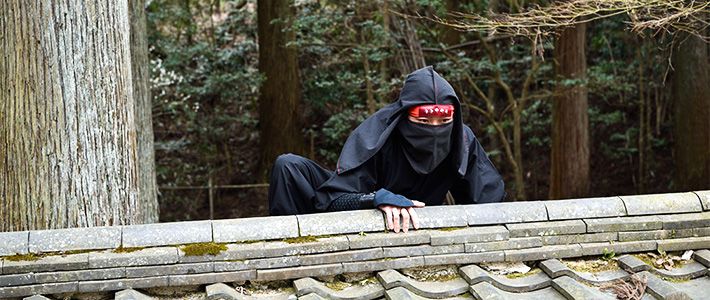
Ninja
Culture- English
- 日本語
- 简体字
- 繁體字
- Français
- Español
- العربية
- Русский
Ninja Fiction
Black-clad ninja endowed with superhuman powers and trained in the clandestine arts of ninjutsu are legendary figures in Japan and, indeed, all around the world. However, the word “ninja” itself did not become widely used in Japan until a boom in popular historical novels from around 1955. These heavily embellished fictional accounts made the most of an image of the warrior spies that was developed after their main period of activity.
Their common past name was shinobi (忍び), which shares the same kanji as nin in ninja (忍者). There is no exact definition, and very little is known for certain about them. The shinobi generally acted as spies who secretly observed the movements of enemies and passed on strategic information. They were most active during the constant turmoil of the Warring States period (1467–1568).
Emergence of Famous Ninja Areas
In the Nara period (710–94), aristocrats, wealthy regional leaders, and temples and shrines began to establish large, private shōen estates, leading to land disputes. Outlaw warrior bands known as akutō formed, and by the second half of the thirteenth century they comprised a major, although loosely grouped, force opposing the shōen system and shogunate. The akutō are thought to have been precursors to the shinobi or ninja.
Shinobi start to appear in historical documents in the fourteenth century. In the Warring States period, daimyō (feudal lords) employed them as a matter of course to scout for necessary intelligence. Some areas became famous for their ninja groups, such as Iga (in present-day Mie Prefecture), Kōka (Shiga Prefecture), Togakushi (Nagano Prefecture), and Kai (Yamanashi Prefecture). There were many local names for ninja, including rappa, suppa, kusa, dakkō, and kamari.
Apart from information gathering in enemy territory, ninja were hired to further war aims via guerrilla tactics including arson, sabotage, and ambush. As their most important role was to report back on the enemy, however, they tended to avoid becoming entangled in unnecessary conflict. Ninjutsu techniques are said to have been used primarily for self-defense.
 Demonstrating katana-kakushi, a ninjutsu method to speedily pull a sword from its place of concealment beneath a floorboard.
Demonstrating katana-kakushi, a ninjutsu method to speedily pull a sword from its place of concealment beneath a floorboard.
Guides to Deception and Infiltration
Tokugawa Ieyasu’s victory at the Battle of Sekigahara brought Japan into an era of relative peace in the Edo period (1603–1868). Ninja began mainly to be employed as personal bodyguards.
In the mid-seventeenth century, ninjutsu books like Bansenshūkai (trans. The Book of Ninja) and Shōninki (trans. True Path of the Ninja) introduced the methods and mindset of the shinobi. Bansenshūkai describes the tools they used, along with techniques for deception and infiltration.
 A museum display of shuriken, or throwing stars.
A museum display of shuriken, or throwing stars.
The growing stability of the shogunate saw a decreased need for the shinobi. As the real-life ninja gradually disappeared, they started to appear in fictional form in arts like kabuki and ukiyo-e. They were commonly depicted wearing black and throwing shuriken blades, as an image was established that endures to this day.
Ninja descendants still live in locations famous for their former traditions. These have now become tourist spots playing on their connection with the fabled masters of stealth. Former residences, museums, and even theme parks initiate visitors into the romance and mystery of the ninja.
 The entrance to the Kōka Ninja House, a hands-on ninjutsu museum in Shiga Prefecture.
The entrance to the Kōka Ninja House, a hands-on ninjutsu museum in Shiga Prefecture.
(Banner photo: A performer at the Kōka Ninja House demonstrates the hei-goe no jutsu, a technique for scaling and creeping over a wall. © Ōshima Takuya.)